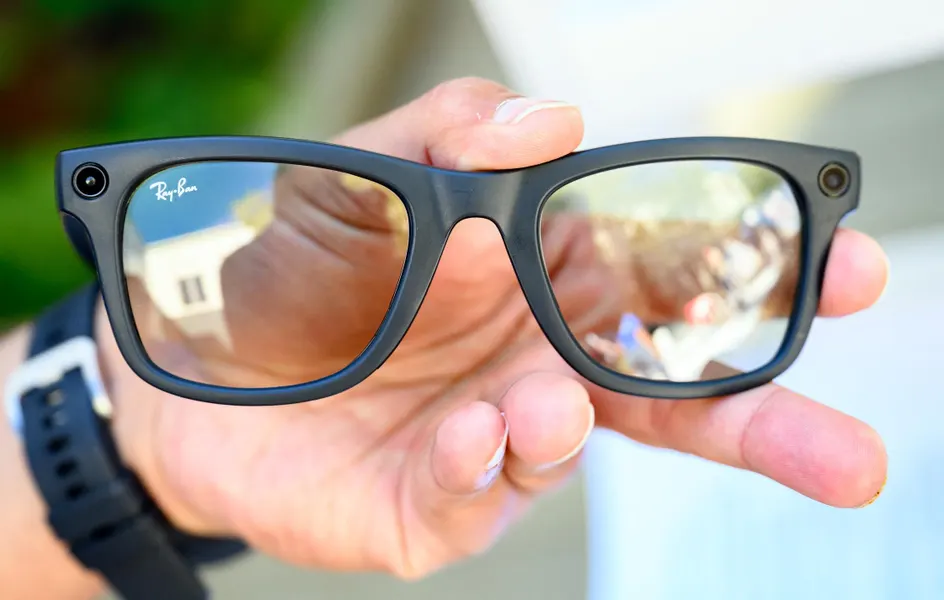
Peering Through the Meta Lens: How AI Glasses Are Rewriting Human Connection
Meta’s AI glasses—from Ray-Ban to Hypernova—aim to transform how we connect, offering immersive presence through smart features like real-time translation, holograms, and AI assistance. But while the tech brings us closer, it can’t replace a hug. The promise of deeper connection is real—but so are the limits.
Meta’s cutting-edge AI glasses, including the Ray-Ban Meta and the upcoming Hypernova models, are set to transform how people connect, learn, and entertain themselves. With functionalities ranging from real-time translation to immersive mixed reality experiences, these devices hold the promise of deepening presence and personalization—while still struggling with the age-old need for human touch. This post explores their tech, the human stories they enable, and the very real challenges that remain.
I remember the first time my grandmother heard my voice on a long-distance call; she laughed, startled, as if witchcraft had transported me into her kitchen. Decades later, Mark Zuckerberg is telling the world that soon a pair of glasses could put my hologram in her living room. It’s tempting to see this as the natural next step; but is high-tech “presence” the same as being there? In this deep dive, we’ll sift through the buzz, the reality, and the hope built into Meta’s latest AI-powered eyewear.
Tony Stark Dreams Meet Everyday Reality: The Ray-Ban Meta Glasses Promise
For years, the idea of slipping on a pair of glasses and seeing digital worlds layered over reality felt like pure science fiction—a fantasy reserved for comic book heroes and blockbuster movies. But as Meta CEO Mark Zuckerberg revealed in a recent interview, the future is arriving faster than most imagined. The Ray-Ban Meta Glasses, sometimes nicknamed the “real life Tony Stark glasses” by Meta’s own engineers, are the result of a decade-long quest to blend advanced technology with everyday eyewear.
Meta spent ten years developing these lightweight, full-featured AR glasses, pushing the boundaries of what’s possible in wearable tech. Zuckerberg himself described the journey as “incredibly optimistic,” noting that the company’s vision is to create the next major platform after smartphones. The Ray-Ban Meta Glasses are not just a gadget—they represent a new way to connect, communicate, and experience the world.
Miniaturized Marvels: The Technology Inside
What makes the Ray-Ban Meta Glasses so remarkable is the sheer amount of technology packed into a familiar, stylish frame. According to research and Meta’s own disclosures, these Meta AI Glasses feature:
- Built-in cameras for capturing photos and video hands-free
- Open-ear audio that lets users listen to music or calls without blocking out the world
- Waveguide displays and micro projectors for overlaying digital content directly onto the user’s field of view
- Eye tracking, nano-etched holograms, and a suite of sensors for immersive, interactive experiences
- Microphones, speakers, and a wrist-based neural interface for intuitive controls
The journey to miniaturize all these components—displays, sensors, audio, batteries—into a standard-looking pair of Ray-Bans was no small feat. As Zuckerberg explained, “These are the first full holographic augmented reality glasses I think that exist in the world.”
“These are the first full holographic augmented reality glasses I think that exist in the world.” – Mark Zuckerberg
From Demo to Daily Life: Interactive Holograms and Social Sharing
So what can these Ray-Ban Meta Glasses actually do? In early demonstrations, users experienced interactive holographic games—think ping pong or poker—projected right into their living rooms. The field of view is wide, supporting full holograms that can be manipulated and shared with friends in real time. Only a few thousand demo units exist so far, but Meta is already working on a major consumer version.
The built-in display and Meta AI features are designed for seamless integration into daily life. Users can take photos, record video, and share moments instantly to social media without ever reaching for their phones. Open-ear audio means you can listen to music, take calls, or get real-time translation without isolating yourself from your surroundings. Research shows that these camera and audio capabilities are central to the promise of Meta AI Glasses, enabling new forms of connection and collaboration.
Redefining Human Connection in a Digital Age
The implications go beyond entertainment. Meta’s vision for smart eyewear immersion is about rewriting how people connect. As Zuckerberg pointed out, the average American now has fewer friends than 15 years ago (0:21–0:26). The hope is that technology like the Ray-Ban Meta Glasses can bridge that gap, making digital presence feel more real and personal. Features like immersive calls, collaborative games, and interactive apps hint at a future where distance matters less, and shared experiences become richer.
Prototype versions of the Ray-Ban Meta Glasses are already showing potential for educational and productivity tools as well. Imagine students exploring virtual science labs or professionals collaborating on 3D models, all through a pair of glasses that look and feel like something you’d wear every day.
The journey isn’t over. Meta continues to refine the technology, with future versions promising even more advanced built-in displays, improved cameras, and expanded Meta AI features. For now, the Ray-Ban Meta Glasses stand as a testament to what’s possible when hardware innovation meets a bold vision for human connection.
The Many Faces of Smart Glasses: From Ray-Ban to Hypernova (and Beyond)
The landscape of smart glasses is rapidly evolving, with Meta leading the charge through a diverse product roadmap that spans from affordable, AI-powered eyewear to high-end augmented reality (AR) devices. As the company pushes boundaries, the Ray-Ban Meta Glasses, upcoming Hypernova models, and even Oakley-branded options are carving out distinct spaces in the market—each targeting unique audiences and use cases.
Meta’s Vision: From Display-less to Holographic
Meta’s journey into smart glasses began nearly a decade ago, with the ambitious goal of miniaturizing advanced technology into a “normal looking pair of glasses” . Mark Zuckerberg himself reflected on the skepticism the team faced, but emphasized the progress made: “I think you not only—we’re going to be able to do this, but I think we’re going to get it cheaper and higher quality and even smaller and more stylish over time. So, I think this is going to be a pretty wild future”.
The company’s approach is multi-pronged. At one end, there are the display-less Ray-Ban Meta Glasses, designed for those seeking affordability and seamless AI features without the distraction of a built-in display. On the other, Meta is developing advanced AR hardware capable of projecting full holographic images, aiming for that “science fiction future” many have imagined.
Ray-Ban Meta Glasses: Affordable Entry Point for AI Features
Ray-Ban Meta Glasses have quickly become the face of accessible smart eyewear. These models, which launched as affordable entry-level devices, focus on integrating AI features such as real-time translation, hands-free assistance, and smart memory. The absence of a built-in display keeps Smart Glasses Pricing competitive, while open-ear audio and discreet cameras enable users to capture moments and interact with Meta AI Features naturally.
Partnerships have been key to expanding the utility of Ray-Ban Meta Glasses. Integration with accessibility apps like Be My Eyes supports visually impaired users, while connections to Spotify, Amazon Music, and Audible allow for voice-controlled media playback. Research shows that these collaborations are broadening the appeal and functionality of the glasses, making them more than just a tech novelty.
Hypernova: Premium AR with a Built-in Display
Looking ahead, Meta’s upcoming Hypernova smart glasses are set to redefine what premium AR eyewear can offer. Slated for a 2025 release, Hypernova will introduce a built-in, monocular display—initially located in the lower-right quadrant of the right lens—with future upgrades planned for binocular displays. The Smart Glasses Pricing for Hypernova is expected to land between $1,000 and $1,400, reflecting its advanced capabilities and upgraded cameras.
According to Meta, this heads-up display (HUD) approach strikes a balance between full AR and audio-only AI glasses. It offers more information at a glance—such as messages, directions, or AI-generated insights—without the complexity or cost of full holographic projection. As Zuckerberg explained, “I think there’s going to be something in between…that’s basically a heads-up display, so it’s not a 70° field of view, maybe it’s a 20° or 30° field of view…there’s a lot of value for heads up display that will be somewhat more expensive than the [Ray-Ban Meta Glasses]”.
Market Segmentation: A Product for Every User
Meta’s strategy is clear: offer a range of smart glasses to suit different needs and budgets. The Ray-Ban Meta Glasses remain the go-to for those seeking affordable, AI-driven experiences. Hypernova, with its built-in display and premium price point, targets early adopters and tech enthusiasts eager for more immersive AR. Meanwhile, Oakley-branded models are in development for athletes, promising sportier designs and specialized features.
“I think there are going to be a bunch of different…product lines that people will choose.” – Mark Zuckerberg
This segmentation reflects broader trends in wearable technology. Studies indicate that as generative AI and AR capabilities mature, consumers will demand devices tailored to their lifestyles—whether that means hands-free productivity, enhanced accessibility, or real-time connection to digital content.
Partnerships and the Expanding Ecosystem
Meta’s commitment to partnerships is driving feature diversity across its smart glasses lineup. By working with external app developers and accessibility advocates, the company is ensuring that its products remain relevant and useful in everyday life. The integration of Meta AI Features, built-in cameras, and open-ear audio is just the beginning. As the ecosystem grows, so too will the possibilities for how smart glasses can reshape the way people connect, consume information, and experience the world.
Social Presence Reimagined: What AI Can—and Can’t—Replace
Meta’s vision for the future of human connection is bold, ambitious, and unmistakably rooted in the promise of AI personalized experiences. At the heart of this vision is the concept of “presence”—the visceral sense of truly being with someone, even when separated by continents. As Mark Zuckerberg put it,
“What people are really reacting to is that they actually for the first time with technology feel a sense of presence like they’re in a place with the person.”.
The company’s latest push, embodied by the Ray-Ban Meta Glasses and the upcoming Hypernova smart glasses, aims to make this digital presence feel more authentic than ever. These AI-powered glasses are equipped with cameras, microphones, and a growing suite of sensors—tools that promise to deliver context-aware assistance and generative AI features right before your eyes. With Meta’s Llama models and Meta AI, the technology is evolving to understand not just global trends, but the intimate, real-time context of each user’s life.
This is not just about seeing or hearing; it’s about making technology feel almost human. The glasses, perched on the bridge of your nose, are uniquely positioned to “see what you see and hear what you hear,” as Zuckerberg explained. This enables a new level of personalized AI, where the device can respond to your environment, your conversations, and even your mood. It’s a leap from the days of video calls and instant messaging—a move toward a future where digital interactions feel less like a compromise and more like a genuine encounter.
Research shows that mixed reality and AI-powered glasses are opening new channels for authentic human interaction. Real-time translation, for example, is already transforming how families stay connected across language barriers, how remote teams collaborate, and how gamers interact in virtual worlds. Meta’s integration of real-time translation and generative AI into its glasses is not just a technical upgrade; it’s a reimagining of what it means to be together, even when apart.
Yet, for all the progress, there are limits that even the most advanced AI cannot overcome—at least, not yet. Physical touch remains the last frontier. “I miss hugging my mom. Yeah, haptics is hard,” Zuckerberg admitted. Despite lifelike holograms and increasingly personalized experiences, the warmth of a hug or the reassurance of a handshake remains out of reach. Haptic technology challenges persist, and while controllers and force feedback can simulate some sensations—like the ping pong demo Zuckerberg described—the full spectrum of human touch is still elusive.
Meta’s roadmap acknowledges this gap. While eye contact and nuanced facial expressions may soon be convincingly replicated in mixed reality, the company is candid about the hurdles in haptics. The technology can approximate certain sensations, especially in gaming or sports, but the “force feedback” required for something as complex as a virtual wrestling match or a heartfelt embrace is still a distant goal. The company’s ongoing research into haptic gloves and other feedback devices underscores just how challenging this problem is.
Still, the uptake of Meta’s products is staggering. Nearly half the world’s population now uses Meta platforms, and the company’s latest hardware—like the Quest 3S and Quest 3—offers mixed reality at prices well below much of the competition. The Ray-Ban Meta Glasses, with their AI-powered features, are already being used for real-time translation, hands-free assistance, and even accessibility improvements for visually impaired users. Partnerships with apps like “Be My Eyes” and integrations with music services such as Spotify and Amazon Music further expand their utility.
Looking ahead, Meta’s generative AI and real-time translation tools are poised to make digital connection more meaningful and accessible than ever before. But as the company pushes the boundaries of what technology can do, it’s clear that some aspects of human connection—especially the physical—remain irreplaceable. The dream of presence is closer than ever, but the journey to truly bridging the gap between the digital and the tangible continues.
TL;DR: Meta’s AI glasses—think Ray-Ban Meta, Hypernova, and the Quest series—promise a more immersive, personalized, and connected future. But while they bring us closer through holograms and real-time AI, the magic of an actual hug still isn’t in the box.
SmartGlasses, AIPersonalizedExperiences, GenerativeAI, Real-timeTranslation, Ray-BanMetaGlasses, MetaAIGlasses, SmartGlassesPricing, Built-inDisplay, AIFeatures, MixedRealityHeadset,MetaAIglasses, Ray-BanMetaGlasses, Hypernovasmartglasses, AIwearables, smartglassespresence, mixedrealityconnection, MarkZuckerbergAIvision, real-timetranslationglasses, digitalpresencetechnology, hapticlimitationsinAI
#MetaAIGlasses, #MixedRealityHeadset, #Built-inDisplay, #Ray-BanMetaGlasses, #Real-timeTranslation, #AIFeatures, #GenerativeAI, #AIPersonalizedExperiences, #SmartGlasses, #SmartGlassesPricing,##MetaGlasses, #RayBanMeta, #Hypernova, #AIandConnection, #SmartWearables, #MixedReality, #HolographicPresence, #HumanTouchInTech, #ZuckerbergVision, #DigitalTogetherness

